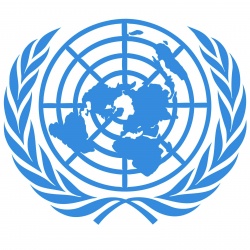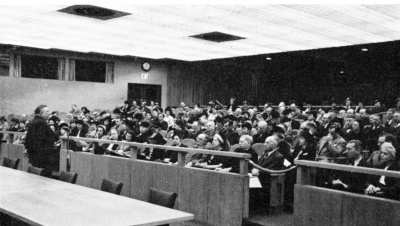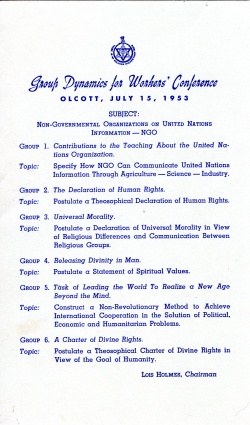United Nations
The United Nations is an intergovernmental organization founded in 1945, with stated aims that include promoting cooperation in international law, international security, economic development, social progress, human rights, civil rights, civil liberties, political freedoms, democracy, and the achievement of lasting world peace. Theosophists have been supportive of the United Nations since its inception. Some TS groups celebrate United Nations Day on October 24.
Blavatsky and the United Nations
Joy Mills wrote an article about "H. P. B. and the U. N." in 1970, discussing the views of Theosophical Society Founder Helena Petrovna Blavatsky:
To link H. P. B. and the U. N. may seem incongruous. Yet there is certainly a relationship between the goal which she set forth in the re-enunciation of an ageless wisdom concerning man and the efforts to realize that goal in practicality through world order under world law. The alternative is world chaos and world destruction. In May 1889, H. P. B. published in her journal, Lucifer, an analysis of “Our Cycle and the Next,” stating unequivocally: “If Theosophy prevailing in the struggle, its all-embracing philosophy strikes deep root into the minds and hearts of men, if its doctrines of Reincarnation and Karma, in other words, of Hope and Responsibility, find a home in the lives of the new generations, then, indeed, will dawn the day of joy and gladness for all who now suffer and are outcast. For real Theosophy is ALTRUISM, and we cannot repeat it too often. It is brotherly love, mutual help, un-swerving devotion to Truth. If once men do but realize that in these alone can true happiness be found, and never in wealth, possessions, or any selfish gratification, then the dark clouds will roll away, and a new humanity will be born upon the earth. Then, the GOLDEN AGE will be here, indeed...
The Theosophical Society, dedicated from its inception to the ideal of brotherhood, has been called the first United Nations, comprising as it does within its membership individuals of many nations, many cultural and ethnic backgrounds. If we who are its members today, building out of all differences and distinctions a unique harmony of purpose, remain loyal to the vision toward which H. P. B. pointed, it may be our privilege to portray the pattern of a truly universal brotherhood of humanity, founded on the spiritual perception of man’s essential nature. No higher privilege could come to any group of men and women, but the price of brotherhood is paid with the currency of present action, not the promissory notes of tomorrow’s good intentions.[1]
Theosophists anticipating need for United Nations
James S. Perkins, President of the Theosophical Society in America from 1945-1960, spoke in a public lecture in 1942 about the need for an international structure:
If the postwar world establishes a federation of free peoples, strong enough to promise the end of military aggression, “we will have a world in which human intelligence will organize and distribute the ample resources of Nature and devote itself to human progress rather than to destruction,” James S. Perkins, vice-president of the Theosophical Society in America, said in a lecture at the society’s rooms here last night.
“But tomorrow’s world,” he cautioned, “will inevitably grow out of today’s acts. Since human progress advances or falls upon the moral and spiritual integrity of the main body of its individuals, the condition of tomorrow’s world rests squarely upon the question whether men in their daily lives are giving expression to those universal principles which are the ethical foundations of any great and enduring world order.”[2]
Involvement of Theosophical Society (Adyar)
After World War II, James Perkins was appointed by Adyar president C. Jinarājadāsa to be the Theosophical Society's delegate to the opening conference of international groups, held at Lake Success, New York on February 10-14, 1947. About 250 people attended, representing over 100 organizations. This was one of the earliest sessions establishing the now-huge body of nongovernmental organizations (NGOs) that work with the United Nations on many issues.
The program of meetings was designed to be primarily informational as to the functioning of the Specialized Agencies and Commissions of the Economic and Social Council. There was discussion of ways in which the non-governmental organizations might voluntarily aid in spreading information about the UN. Social opportunities were afforded for the delegates to become acquainted with and to meet informally Mr. Trygve Lie, the Secretary General.
Mrs. Eleanor Roosevelt addressed the delegates at the dinner that closed the sessions.[3]
Perkins wrote about the meeting and described how Theosophists could help the UN in communicating its resources and missions:
It is precisely because the UN is the most advanced effort in the direction of brotherhood ever made by collective mankind that Theosophists should support it in every possible way...
The principle requisite is to stimulate a direct interest in the activities of the UN by broadcasting information about its programs and needs. A study of this world-wide organization of human energy being applied realistically to the major problems of freeing the world of want and fear cannot fail to arouse our interest and enthusiasm. Once grasped, the integrated pattern of the UN's various departments and commissions produces a sense of wholeness which is unfortunately lacking in the minds of most people.
Throughout the conference... the need was expressed again and again to inform people of the world in all languages of the character and the operations of the various departments of the UN. Mrs. Perkins and I were impressed with the unique opportunity afforded individual members of The Theosophical Society and the Theosophical Order of Service to serve in this capacity. Lodges or members can initiate programs to distribute information if they will become acquainted with the general set-up of the UN, discovering what information is available and how it may be used.[4]
The international Theosophical Society applied to be accepted as an official non-governmental organization of the U. N., but the application was not accepted. Most NGOs of that era were aid agencies like the International Red Cross, and the TS did not meet the qualification of having practical experience in dealing with massive post-war social problems.[5] Sidney A. Cook, then Vice President of the international Society, explained that:
It would only impede the work of the United Nations Social and Economic Council if its officers and representatives had to concern themselves with voluminous recommendations from those untrained and unskilled in dealing with large-scale economic and social disruption. The problems to be dealt with are practical ones, and only the views and recommendations of those with practical experience in dealing with such problems are desired.[6]
He went on to express regret that "The United Nations has no department or branch to help men realize their spiritual unity; that the approach to all problems is still mainly on the level of physical recuperation only."[7] His interest in having the Theosophical Society support the United Nations as an NGO continued for some years. On July 15, 1953 the Theosophical Society in America held a conference at its headquarters in Wheaton, Illinois to develop workers who were interested in how the T.S. could work as an NGO for the United Nations.
In 1949:
The Theosophical Society was invited to send five official observers to represent it at sessions of the Third Conference of International Non-Governmental Organizations, held at Lake Success, N.Y., on April 4, 5, 7 and 8, 1949, in conjunction with the Third Session of the United Nations General Assembly.
It was particularly fortunate that the arrival of the President, Mr. C. Jinarajadasa, for his tour of our [American] Section, coincided with these Conference sessions, since for the first time our Society could be represented by its President. Other observers named by the National President, at Mr. Jinarajadasa's request, were Mr. Viggo Westergaard and Mr. Karel van Gelder, members of the New York Theosophical Society, and Miss Elithe Nisewanger from National Headquarters. in addition, Capt. Carl Stillman of the New York Theosophical Society was an alternate observer at some of the sessions.
Mr. Jinarajadasa and two other of the Society's observers were present at Lake Success on April 4 for registration of delegates and the formal opening... [he] also attended a reception given by the American Women's Association in New York City to all delegates of the Third Conference and the General Assembly. On this occasion he was able to meet and have a talk with Mr. J. B. Orrick, Chief of the International Non-Governmental Organizations, Department of Public Information, who stated that he had observed with interest The Theosophical Society's publicizing of the work of the United Nations, and felt that the Society is doing more than any other group in India to familiarize people in that country with the purpose and activities of the United Nations.
Mr. Jinarajadasa has become vice-president of, and has had occasion to address, an association recently organized in Madras, to explain and publicize the work of the United Nations and further stimulate interest in India with regard to its objects and achievements.[8]
Involvement of Theosophical Order of Service
The Theosophical Order of Service in Canada has long supported the United Nations:
TOS groups in Canada are encouraged to hold special events in support of the United Nations as a vehicle for global transformation. In Calgary, the local TOS branch has established a yearly tradition of celebrating UN Day in October. The program each year is centered on a particular theme that encourages Theosophists to support UN initiatives for enlightened social action. Afterwards the group enjoys refreshments and ethnic food, with participants bringing a vegetarian dish from a country of their choice. [9]
Notes
- ↑ "Joy Mills, "H. P. B. and the U. N.," The American Theosophist 58.4 (April, 1970): 70-71.
- ↑ ”Theosophical Society Hears Vice-President,” ‘’Springfield Republican’’ (Springfield, MA) (April 24, 1942), 4.
- ↑ Anonymous, "The Theosophical Society Represented at UN Conference," The American Theosophist 35 no. 3 (March, 1947): 70.
- ↑ James S. Perkins, The American Theosophist 36 no. 5 (May, 1947): 100-101, 114.
- ↑ United Nations correspondence. Adyar Archives.
- ↑ Sidney A. Cook, "The United Nations and the Theosophical Society," The Theosophist 69 no. 5 (February 1948): 347.
- ↑ Sidney A. Cook, "The United Nations and the Theosophical Society," The Theosophist 69 no. 5 (February 1948): 347.
- ↑ Anonymous, "The President Visits the United Nations" American Theosophist 46 no. 5 (May, 1949): 118-119.
- ↑ Lorraine Christensen, "TOS Celebration of United Nations Day," TOS In-Touch.Online e-newsletter EN-42 (January, 2017).


